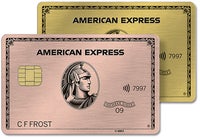Amex Gold vs. Chase Sapphire Preferred

Key takeaways
- The American Express® Gold Card and the Chase Sapphire Preferred® Card are two of the top flexible rewards cards available.
- Both cards are part of premier rewards programs, offering excellent earning potential on travel and dining expenses.
- The right card for you depends on your spending habits, which type of rewards currency you prefer to earn and the amount you’re willing to pay for an annual fee.
When it comes to the best travel credit cards, the American Express® Gold Card and the Chase Sapphire Preferred® Card frequently make the cut. Both cards feature flexible ways to redeem rewards, plus they come with much lower annual fees than top-tier premium travel cards. They also offer boosted rewards in everyday categories, like dining and travel, so they can fit in well in many people’s wallets.
But which of these flexible rewards cards is best for you? That really depends on which categories you spend the most in, as well as which transfer partners you want access to. Read on to learn our take on how these two cards stack up.
Main details
| Cards | American Express® Gold Card | Chase Sapphire Preferred® Card |
| Welcome bonus |
|
Earn 100,000 bonus points after spending $5,000 on purchases within the first three months. |
| Rewards rate |
|
|
| Intro APR | N/A | N/A |
| Annual fee | $325 | $95 |
| Foreign transaction fees | None | None |
Amex Gold Card vs. Chase Sapphire Preferred highlights
Comparing the Amex Gold Card and the Chase Sapphire Preferred can be tricky since these cards both earn points in top rewards programs. However, depending on the bonus category, one card may offer more value than the other.

Chase Sapphire Preferred® Card
-
Chase Sapphire Preferred just dropped one of its biggest limited-time offers for its welcome bonus: New cardholders can earn 100,000 bonus points after spending $5,000 on purchases within three months of account opening. Meanwhile, the Amex Gold Card offers 60,000 points after new cardholders spend $6,000 within six months of account opening. That means you’ll need to spend an average of $1,000 per month for six months to earn the bonus for the Gold card, but Chase Sapphire Preferred requires an average monthly spend of at least $1,667 for three months.
For us, though, Sapphire Preferred still comes out ahead in this category because of the rewards’ value when it comes time to redeem your welcome bonus. According to Bankrate valuations, both Ultimate Rewards and Membership Rewards are worth an average of 2.0 cents each when transferred to a high-value travel partner. But if you aren’t ready to jump into the somewhat complex world of transferring points to travel partners, you can just redeem your Ultimate Rewards points for travel through Chase Travel℠ and they’ll be worth 1.25 cents each, making the welcome bonus worth $1,250.
Membership Rewards points, on the other hand, are only worth 1 cent each when redeemed for flights or booking stays in the Fine Hotels & Resorts program through American Express Travel and only 0.7 cents each when redeemed through the portal for other travel purchases. That means your Amex Gold bonus is worth $600 in flights or specific hotel stays through the portal and just $420 for other travel purchases.

American Express® Gold Card
-
The Amex Gold Card boasts lucrative rewards rates, especially for foodies, but everyone has to eat, right? This card is our winner since it offers high rates in categories that everyone uses. Maxing out the spending caps in the U.S. supermarket (earn 4X points on $25,000 spent annually) and restaurant (4X points on $50,000 spent annually) categories would mean earning 300,000 Membership Rewards points each year on those purchases alone.
For comparison, spending that amount in those categories with the Sapphire Preferred card would only net you 175,000 points (200,000 if all your grocery shopping qualifies for the 2X earning on online grocery purchases).
Still, if travel purchases are a significant part of your budget, Sapphire Preferred may come out ahead. Chase Sapphire Preferred cardholders earn 5X points on any travel booked through Chase Travel (excluding hotel purchases that qualify for the $50 annual hotel credit) plus 2X points on all other travel purchases.

Chase Sapphire Preferred® Card
-
The Amex Gold Card includes an annual fee of $325, whereas the Chase Sapphire Preferred will set you back just $95 per year. The Chase Sapphire Preferred scores an easy win in this category.
-
Neither one of these cards charges foreign transaction fees on purchases made outside the U.S. or in foreign currency. This is an important consideration for frequent travelers or those who shop online in foreign currencies, and both cards are winners here.
-
Likewise, neither of these cards offers an introductory APR on purchases or balance transfers. Thus, neither card has an advantage here.
Which card earns the most?
So, which travel credit card choice will leave you with more rewards in the end? Your own points haul will depend on how much you spend and which categories you spend the most in. Consider the spending example below and how it might look the same (or different) based on your spending habits.
Amex Gold Card vs. Chase Sapphire Preferred spending example
Let’s imagine you have a family of four with two adults and two kids. Additionally, say your average supermarket spending is about $1,224.70 per month (or $14,696.40 per year) on a moderate-spending plan, which is fairly close to the U.S. Department of Agriculture’s report on the average cost of different food plans.
Let’s also imagine that you spend $300 per month ($3,600 per year) at restaurants, $3,600 per year on directly-booked airfare and $3,600 per year on hotels and other travel. You also spend $1,000 per month ($12,000 per year) on miscellaneous purchases.
Here’s how that works out in points earnings within a year:
| Amex Gold | Chase Sapphire Preferred | |
| U.S. supermarkets or online grocery services | 58,786 points | 44,089 points |
| Dining | 14,400 points | 10,800 points |
| Directly-booked airfare | 10,800 points | 18,000 points |
| Prepaid hotels and other eligible travel | 7,200 points | 18,000 points |
| Miscellaneous purchases | 12,000 points | 12,000 points |
| Total points | 103,186 Amex Membership Rewards points | 102,889 Chase Ultimate Rewards points |
As you can see, you’d earn just about 300 more points with the Amex Gold for the same amount of spending than with the Chase Sapphire Preferred. However, the rewards are close enough that the main deciding factor for you may be the benefits and perks that come with these cards.
Why should you get the Amex Gold Card?
The Amex Gold Card’s earning potential may make it seem like a marginal winner, but there are more reasons to consider this card over the Chase Sapphire Preferred.
Why should you get the Chase Sapphire Preferred?
If you’re intrigued by the Chase Sapphire Preferred’s rewards rates and earning potential, you should know there are even more reasons to sign up.
The bottom line
Both the Amex Gold Card and Chase Sapphire Preferred are worth considering if you spend a lot on travel and dining, with both cards offering flexible redemption options on the points you earn. However, the right card for you depends on which categories you spend the most in and how you plan to redeem your rewards.
That said, it never hurts to compare these cards with other top rewards cards, including other cards from Chase and American Express. With some research and comparison shopping, you may be able to find a card that can boost your rewards even more.






